Ce Doping Effects on the Hydrogen Sensing Properties of Graphene/SnO2-Based Sensors
Abstract
:1. Introduction
2. Materials and Methods
2.1. Synthesis of S-4G
2.2. Synthesis of S-4G-xC
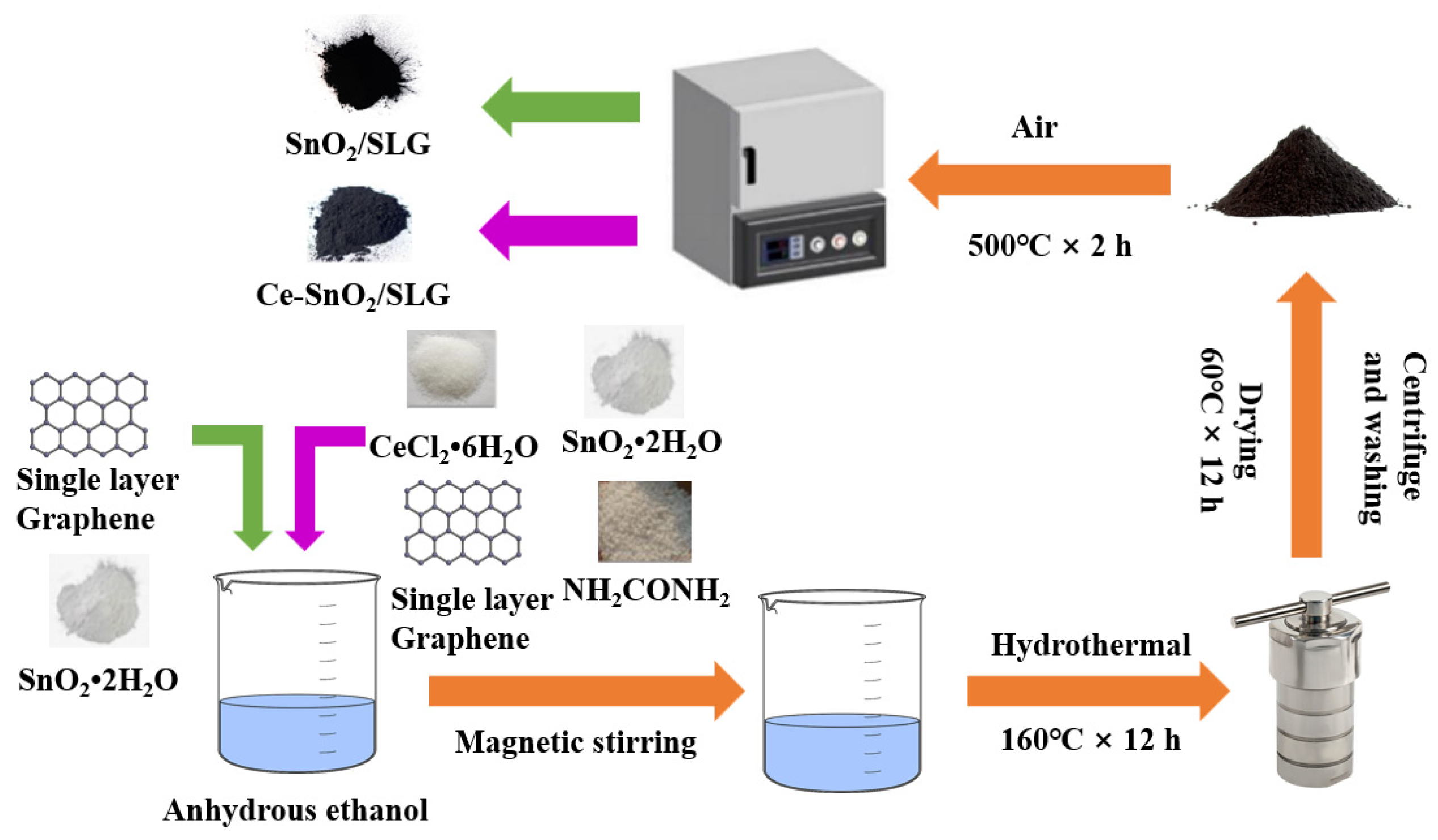
2.3. Characterization
2.4. Fabrication and Performance Test of the Gas Sensor
3. Results and Discussion
3.1. X-ray Diffraction
3.2. Scanning Electron Microscopy
3.3. Transmission Electron Microscopy
3.4. X-ray Photoelectron Spectroscopy
3.5. Raman Spectroscopy
3.6. Gas Sensing Properties
3.7. Sensing Mechanism
4. Conclusions
Author Contributions
Funding
Institutional Review Board Statement
Informed Consent Statement
Data Availability Statement
Conflicts of Interest
References
- Wang, J.; Kwak, Y.; Lee, I.-y.; Maeng, S.; Kim, G.-H. Highly responsive hydrogen gas sensing by partially reduced graphite oxide thin films at room temperature. Carbon 2012, 50, 4061–4067. [Google Scholar] [CrossRef]
- Gao, L.; Tian, Y.; Hussain, A.; Guan, Y.; Xu, G. Recent developments and challenges in resistance-based hydrogen gas sensors based on metal oxide semiconductors. Anal. Bioanal. Chem. 2024, 416, 3697–3715. [Google Scholar] [CrossRef]
- Liu, P.; Han, X. Comparative analysis on similarities and differences of hydrogen energy development in the World’s top 4 largest economies: A novel framework. Int. J. Hydrogen Energy 2022, 47, 9485–9503. [Google Scholar]
- Anand, K.; Singh, O.; Singh, M.P.; Kaur, J.; Singh, R.C. Hydrogen sensor based on graphene/ZnO nanocomposite. Sens. Actuators B-Chem. 2014, 195, 409–415. [Google Scholar] [CrossRef]
- Wang, J.; Singh, B.; Park, J.-H.; Rathi, S.; Lee, I.-y.; Maeng, S.; Joh, H.-I.; Lee, C.-H.; Kim, G.-H. Dielectrophoresis of graphene oxide nanostructures for hydrogen gas sensor at room temperature. Sens. Actuators B-Chem. 2014, 194, 296–302. [Google Scholar] [CrossRef]
- Chauhan, P.S.; Bhattacharya, S. Hydrogen gas sensing methods, materials, and approach to achieve parts per billion level detection: A review. Int. J. Hydrogen Energy 2019, 44, 26076–26099. [Google Scholar] [CrossRef]
- Abdulhameed, A.; Mahnashi, Y. Fabrication of carbon nanotube/titanium dioxide nanomaterials-based hydrogen sensor using novel two-stage dielectrophoresis process. Mater. Sci. Semicond. Process. 2023, 167, 107794–107805. [Google Scholar] [CrossRef]
- Singh, G.; Kohli, N.; Singh, R.C. Preparation and characterization of Eu-doped SnO2 nanostructures for hydrogen gas sensing. J. Mater. Sci.-Mater. Electron. 2017, 28, 2257–2266. [Google Scholar] [CrossRef]
- Enachi, M.; Lupan, O.; Braniste, T.; Sarua, A.; Chow, L.; Mishra, Y.K.; Gedamu, D.; Adelung, R.; Tiginyanu, I. Integration of individual TiO2 nanotube on the chip: Nanodevice for hydrogen sensing. Phys. Status Solidi-Rapid Res. Lett. 2015, 9, 171–174. [Google Scholar] [CrossRef]
- Singh, O.; Singh, R.C. Enhancement in ethanol sensing response by surface activation of ZnO with SnO2. Mater. Res. Bull. 2012, 47, 557–561. [Google Scholar] [CrossRef]
- Cretu, V.; Postica, V.; Mishra, A.K.; Hoppe, M.; Tiginyanu, I.; Mishra, Y.K.; Chow, L.; de Leeuw, N.H.; Adelung, R.; Lupan, O. Synthesis, characterization and DFT studies of zinc-doped copper oxide nanocrystals for gas sensing applications. J. Mater. Chem. A 2016, 4, 6527–6539. [Google Scholar] [CrossRef]
- Kohli, N.; Singh, O.; Singh, R.C. Influence of pH on particle size and sensing response of chemically synthesized chromium oxide nanoparticles to alcohols. Sens. Actuators B-Chem. 2011, 158, 259–264. [Google Scholar] [CrossRef]
- Ab Kadir, R.; Li, Z.; Sadek, A.Z.; Rani, R.A.; Zoolfakar, A.S.; Field, M.R.; Ou, J.Z.; Chrimes, A.F.; Kalantar-zadeh, K. Electrospun Granular Hollow SnO2 Nanofibers Hydrogen Gas Sensors Operating at Low Temperatures. J. Phys. Chem. C 2014, 118, 3129–3139. [Google Scholar] [CrossRef]
- Wang, Y.; Liu, C.; Wang, L.; Liu, J.; Zhang, B.; Gao, Y.; Sun, P.; Sun, Y.; Zhang, T.; Lu, G. Horseshoe-shaped SnO2 with annulus-like mesoporous for ethanol gas sensing application. Sens. Actuators B-Chem. 2017, 240, 1321–1329. [Google Scholar] [CrossRef]
- Kida, T.; Fujiyama, S.; Suematsu, K.; Yuasa, M.; Shimanoe, K. Pore and Particle Size Control of Gas Sensing Films Using SnO2 Nanoparticles Synthesized by Seed-Mediated Growth: Design of Highly Sensitive Gas Sensors. J. Phys. Chem. C 2013, 117, 17574–17582. [Google Scholar] [CrossRef]
- Lupan, O.; Postica, V.; Labat, F.; Ciofini, I.; Pauporte, T.; Adelung, R. Ultra-sensitive and selective hydrogen nanosensor with fast response at room temperature based on a single Pd/ZnO nanowire. Sens. Actuators B-Chem. 2018, 254, 1259–1270. [Google Scholar] [CrossRef]
- Cho, N.G.; Whitfield, G.C.; Yang, D.J.; Kim, H.-G.; Tuller, H.L.; Kim, I.-D. Facile Synthesis of Pt-Functionalized SnO2 Hollow Hemispheres and Their Gas Sensing Properties. J. Electrochem. Soc. 2010, 157, J435–J439. [Google Scholar] [CrossRef]
- Lin, Z.; Li, N.; Chen, Z.; Fu, P. The effect of Ni doping concentration on the gas sensing properties of Ni doped SnO2. Sens. Actuators B-Chem. 2017, 239, 501–510. [Google Scholar] [CrossRef]
- Lin, Y.; Wei, W.; Li, Y.; Li, F.; Zhou, J.; Sun, D.; Chen, Y.; Ruan, S. Preparation of Pd nanoparticle-decorated hollow SnO2 nanofibers and their enhanced formaldehyde sensing properties. J. Alloys Compd. 2015, 651, 690–698. [Google Scholar] [CrossRef]
- Shaalan, N.M.; Yamazaki, T.; Kikuta, T. Influence of morphology and structure geometry on NO2 gas-sensing characteristics of SnO2 nanostructures synthesized via a thermal evaporation method. Sens. Actuators B-Chem. 2011, 153, 11–16. [Google Scholar] [CrossRef]
- Chen, Y.; Yu, L.; Feng, D.; Zhuo, M.; Zhang, M.; Zhang, E.; Xu, Z.; Li, Q.; Wang, T. Superior ethanol-sensing properties based on Ni-doped SnO2 p-n heterojunction hollow spheres. Sens. Actuators B-Chem. 2012, 166, 61–67. [Google Scholar] [CrossRef]
- Xiao, L.; Shu, S.; Liu, S. A facile synthesis of Pd-doped SnO2 hollow microcubes with enhanced sensing performance. Sens. Actuators B-Chem. 2015, 221, 120–126. [Google Scholar] [CrossRef]
- Meyer, J.C.; Girit, C.O.; Crommie, M.F.; Zettl, A. Imaging and dynamics of light atoms and molecules on graphene. Nature 2008, 454, 319–322. [Google Scholar] [CrossRef] [PubMed]
- Reddy, C.S.; Zhang, L.; Qiu, Y.; Chen, Y.; Reddy, A.S.; Reddy, P.S.; Dugasani, S.R. Investigation of hydrogen sensing properties of graphene/Al-SnO2 composite nanotubes derived from electrospinning. J. Ind. Eng. Chem. 2018, 63, 411–419. [Google Scholar]
- Li, G.; Shen, Y.; Zhao, S.; Li, A.; Han, C.; Zhao, Q.; Wei, D.; Yuan, Z.; Meng, F. Novel sensitizer AuxSn modify rGO-SnO2 nanocomposites for enhancing detection of sub-ppm H2. Sens. Actuators B-Chem. 2022, 373, 132656. [Google Scholar] [CrossRef]
- Kim, H.; Pak, Y.; Jeong, Y.; Kim, W.; Kim, J.; Jung, G.Y. Amorphous Pd-assisted H2 detection of ZnO nanorod gas sensor with enhanced sensitivity and stability. Sens. Actuators B-Chem. 2018, 262, 460–468. [Google Scholar] [CrossRef]
- Lupan, O.; Postica, V.; Wolff, N.; Su, J.; Labat, F.; Ciofini, I.; Cavers, H.; Adelung, R.; Polonskyi, O.; Faupel, F.; et al. Low-Temperature Solution Synthesis of Au-Modified ZnO Nanowires for Highly Efficient Hydrogen Nanosensors. Acs Appl. Mater. Interfaces 2019, 11, 32115–32126. [Google Scholar] [CrossRef]
- Li, T.; Zhou, P.; Zhao, S.; Han, C.; Wei, D.; Shen, Y.; Liu, T. NH3 sensing performance of Pt-doped WO3•0.33H2O microshuttles induced from scheelite leaching solution. Vacuum 2021, 184, 109936. [Google Scholar] [CrossRef]
- Liu, B.; Cai, D.; Liu, Y.; Wang, D.; Wang, L.; Wang, Y.; Li, H.; Li, Q.; Wang, T. Improved room-temperature hydrogen sensing performance of directly formed Pd/WO3 nanocomposite. Sens. Actuators B-Chem. 2014, 193, 28–34. [Google Scholar] [CrossRef]
- Kumar, S.; Lawaniya, S.D.; Agarwal, S.; Yu, Y.-T.; Nelamarri, S.R.; Kumar, M.; Mishra, Y.K.; Awasthi, K. Optimization of Pt nanoparticles loading in ZnO for highly selective and stable hydrogen gas sensor at reduced working temperature. Sens. Actuators B-Chem. 2023, 375, 132943. [Google Scholar] [CrossRef]
- Boudjahem, A.-G.; Bettahar, M.M. Effect of oxidative pre-treatment on hydrogen spillover for a Ni/SiO2 catalyst. J. Mol. Catal. A-Chem. 2017, 426, 190–197. [Google Scholar] [CrossRef]
- Singh, G.; Virpal; Singh, R.C. Highly sensitive gas sensor based on Er-doped SnO2 nanostructures and its temperature dependent selectivity towards hydrogen and ethanol. Sens. Actuators B-Chem. 2019, 282, 373–383. [Google Scholar] [CrossRef]
- Motaung, D.E.; Mhlongo, G.H.; Makgwane, P.R.; Dhonge, B.P.; Cummings, F.R.; Swart, H.C.; Ray, S.S. Ultra-high sensitive and selective H2 gas sensor manifested by interface of n-n heterostructure of CeO2-SnO2 nanoparticles. Sens. Actuators B-Chem. 2018, 254, 984–995. [Google Scholar] [CrossRef]
- Fang, J.Y. Study on the Effects of Ce and Single Layer Graphene Doping on the Sensing Performance and Mechanism of SnO2 Hydrogen Sensitive Materials. Master’s Thesis, Shanghai University, Shanghai, China, 2024. [Google Scholar]
- Sui, L.-L.; Xu, Y.-M.; Zhang, X.-F.; Cheng, X.-L.; Gao, S.; Zhao, H.; Cai, Z.; Huo, L.-H. Construction of three-dimensional flower-like α-MoO3 with hierarchical structure for highly selective triethylamine sensor. Sens. Actuators B-Chem. 2015, 208, 406–414. [Google Scholar] [CrossRef]
- Chen, L.; Shi, H.; Ye, C.; Xia, X.; Li, Y.; Pan, C.; Song, Y.; Liu, J.; Dong, H.; Wang, D.; et al. Enhanced ethanol-sensing characteristics of Au decorated In-doped SnO2 porous nanotubes at low working temperature. Sens. Actuators B-Chem. 2023, 375, 132864. [Google Scholar] [CrossRef]
- Li, Z.; Yang, Q.; Wu, Y.; He, Y.; Chen, J.; Wang, J. La3+ doped SnO2 nanofibers for rapid and selective H2 sensor with long range linearity. Int. J. Hydrogen Energy 2019, 44, 8659–8668. [Google Scholar] [CrossRef]
- Hu, J.; Chen, M.; Rong, Q.; Zhang, Y.; Wang, H.; Zhang, D.; Zhao, X.; Zhou, S.; Zi, B.; Zhao, J.; et al. Formaldehyde sensing performance of reduced graphene oxide-wrapped hollow SnO2 nanospheres composites. Sens. Actuators B-Chem. 2020, 375, 132864. [Google Scholar] [CrossRef]
- Si, R.; Xu, Y.; Shen, C.; Jiang, H.; Lei, M.; Guo, X.; Xie, S.; Gao, S.; Zhang, S. High-Selectivity Laminated Gas Sensor Based on Characteristic Peak under Temperature Modulation. ACS Sens. 2024, 9, 674–688. [Google Scholar] [CrossRef]
- Inyawilert, K.; Wisitsoraat, A.; Sriprachaubwong, C.; Tuantranont, A.; Phanichphant, S.; Liewhiran, C. Rapid ethanol sensor based on electrolytically-exfoliated graphene-loaded flame-made In-doped SnO2 composite film. Sens. Actuators B-Chem. 2015, 209, 40–55. [Google Scholar] [CrossRef]
- Choi, M.S.; Bang, J.H.; Mirzaei, A.; Oum, W.; Na, H.G.; Jin, C.; Kim, S.S.; Kim, H.W. Promotional effects of ZnO-branching and Au-functionalization on the surface of SnO2 nanowires for NO2 sensing. J. Alloys Compd. 2019, 786, 27–39. [Google Scholar] [CrossRef]
- Nguyen Van, T.; Nguyen Viet, C.; Nguyen Van, D.; Hoang Si, H.; Nguyen, H.; Nguyen Duc, H.; Nguyen Van, H. Fabrication of highly sensitive and selective H2 gas sensor based on SnO2 thin film sensitized with microsized Pd islands. J. Hazard. Mater. 2016, 301, 433–442. [Google Scholar] [PubMed]
- Zhao, Q.; Deng, X.; Ding, M.; Gan, L.; Zhai, T.; Xu, X. One-pot synthesis of Zn-doped SnO2 nanosheet-based hierarchical architectures as a glycol gas sensor and photocatalyst. CrystEngComm 2015, 17, 4394–4401. [Google Scholar] [CrossRef]
- Gyger, F.; Hübner, M.; Feldmann, C.; Barsan, N.; Weimar, U. Nanoscale SnO2 Hollow Spheres and Their Application as a Gas-Sensing Material. Chem. Mater. 2010, 22, 4821–4827. [Google Scholar] [CrossRef]
- Nadargi, D.Y.; Umar, A.; Nadargi, J.D.; Lokare, S.A.; Akbar, S.; Mulla, I.S.; Suryavanshi, S.S.; Bhandari, N.L.; Chaskar, M.G. Gas sensors and factors influencing sensing mechanism with a special focus on MOS sensors. J. Mater. Sci. 2023, 58, 559–582. [Google Scholar] [CrossRef]
- Ahemad, M.J.; Hyung, S.-K.; Yun, H.; Im, M.; Lee, E.; Choi, J.H.; Kim, T.-W.; Lee, S.-K.; Moon, B.J.; Bae, S. In-situ Synthesis of Pd/WO3 Nanocomposites for Low-Temperature Hydrogen Gas Sensing. Appl. Sci. Converg. Technol. 2023, 32, 100–103. [Google Scholar] [CrossRef]
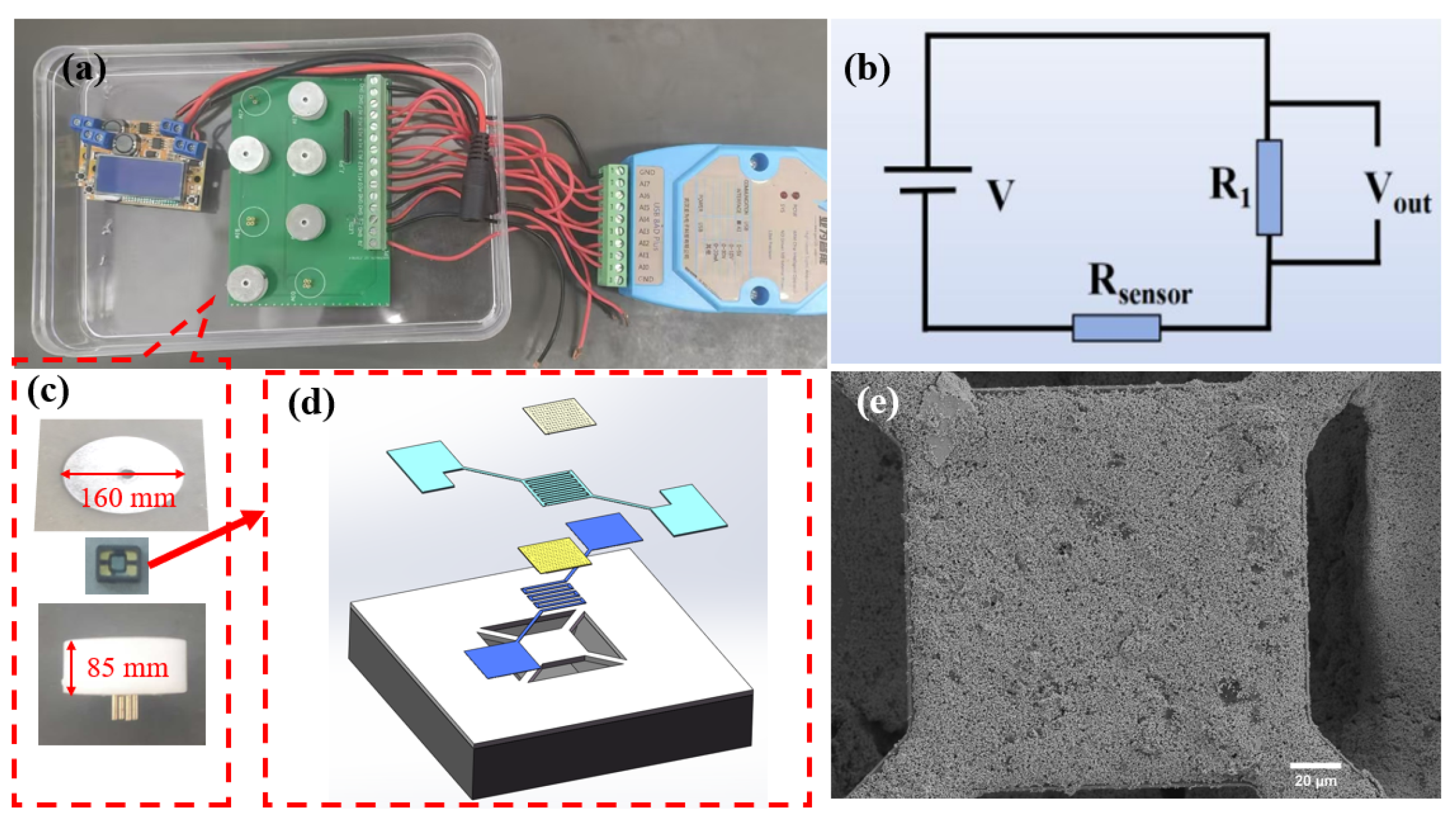
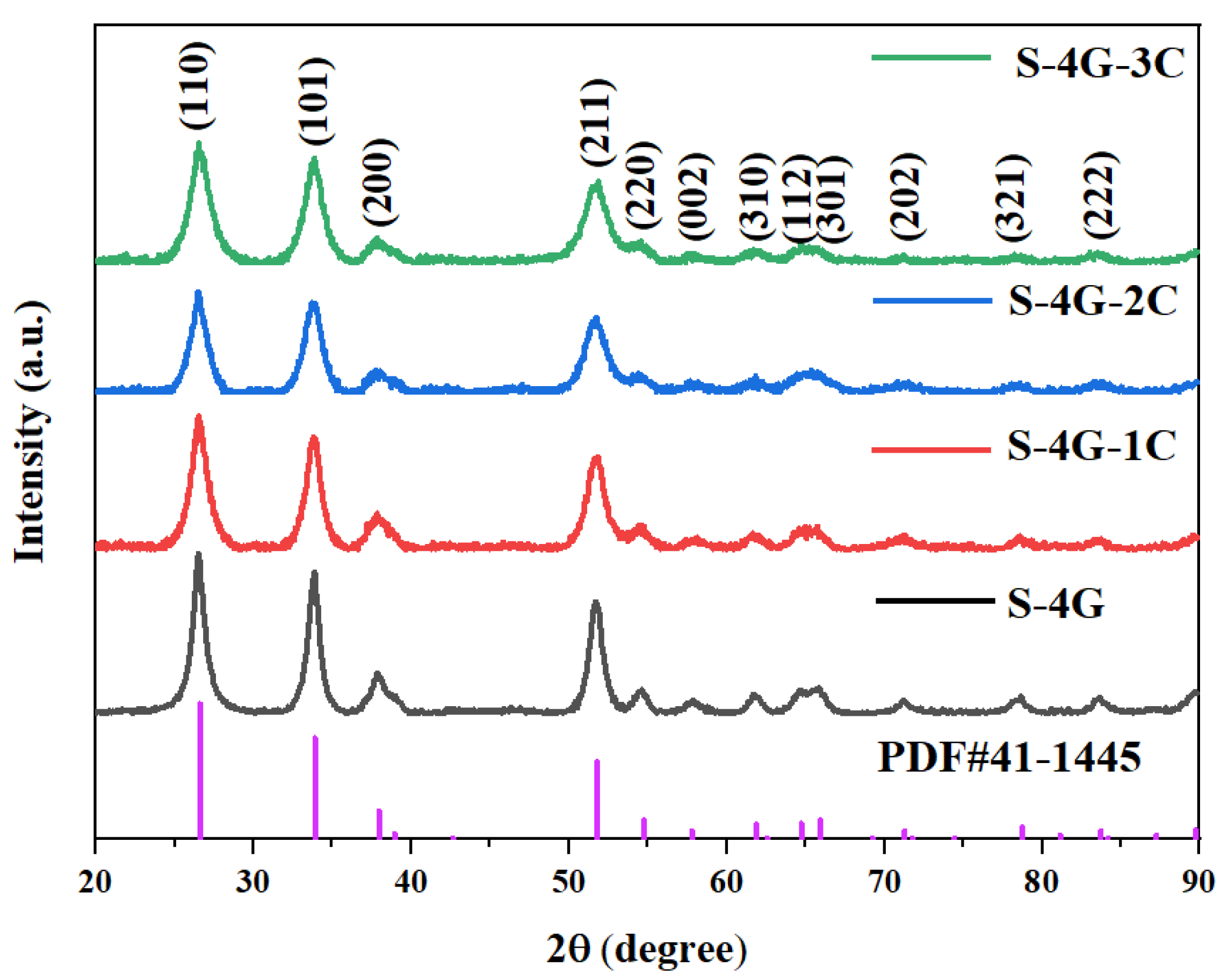
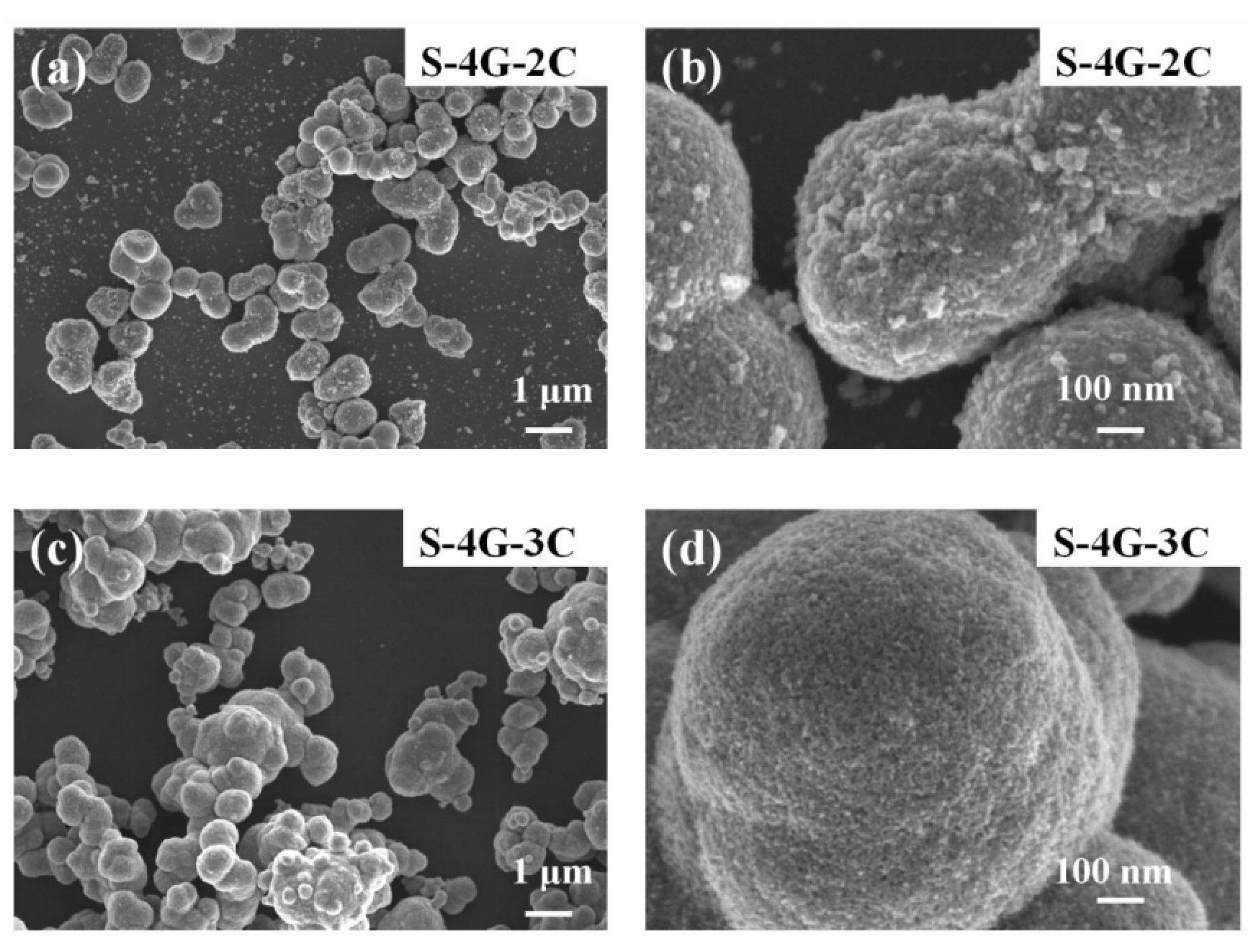
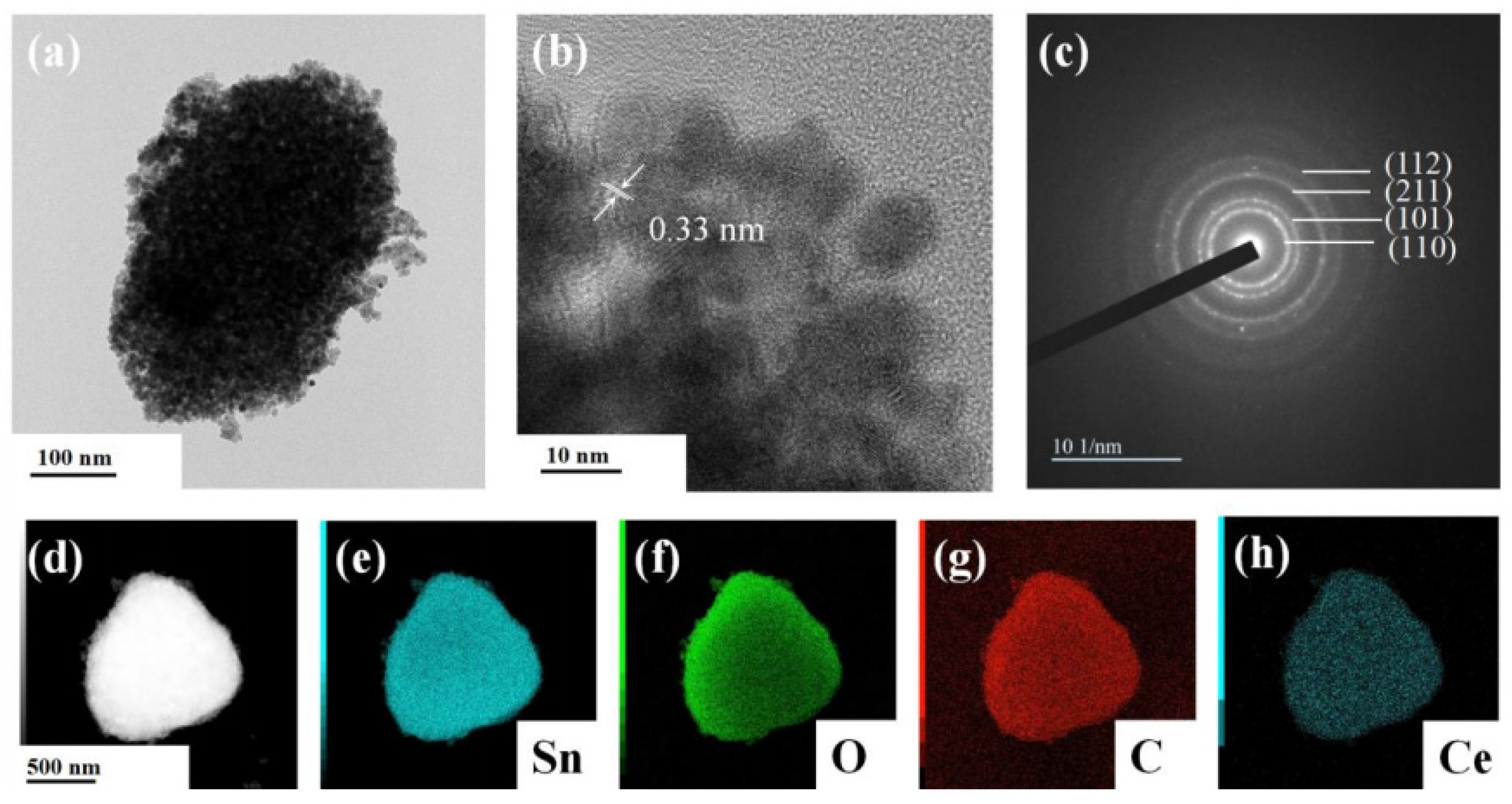
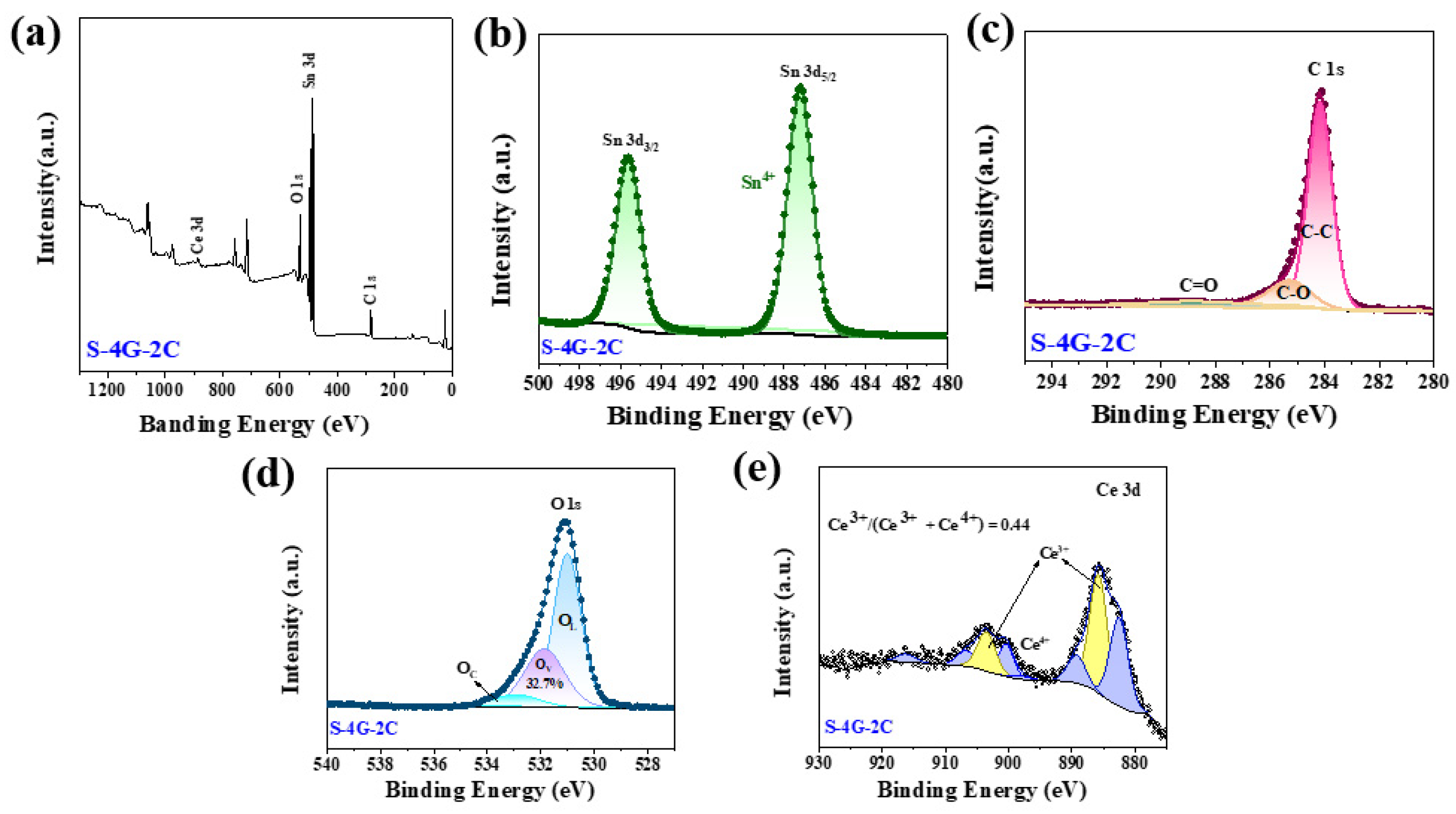
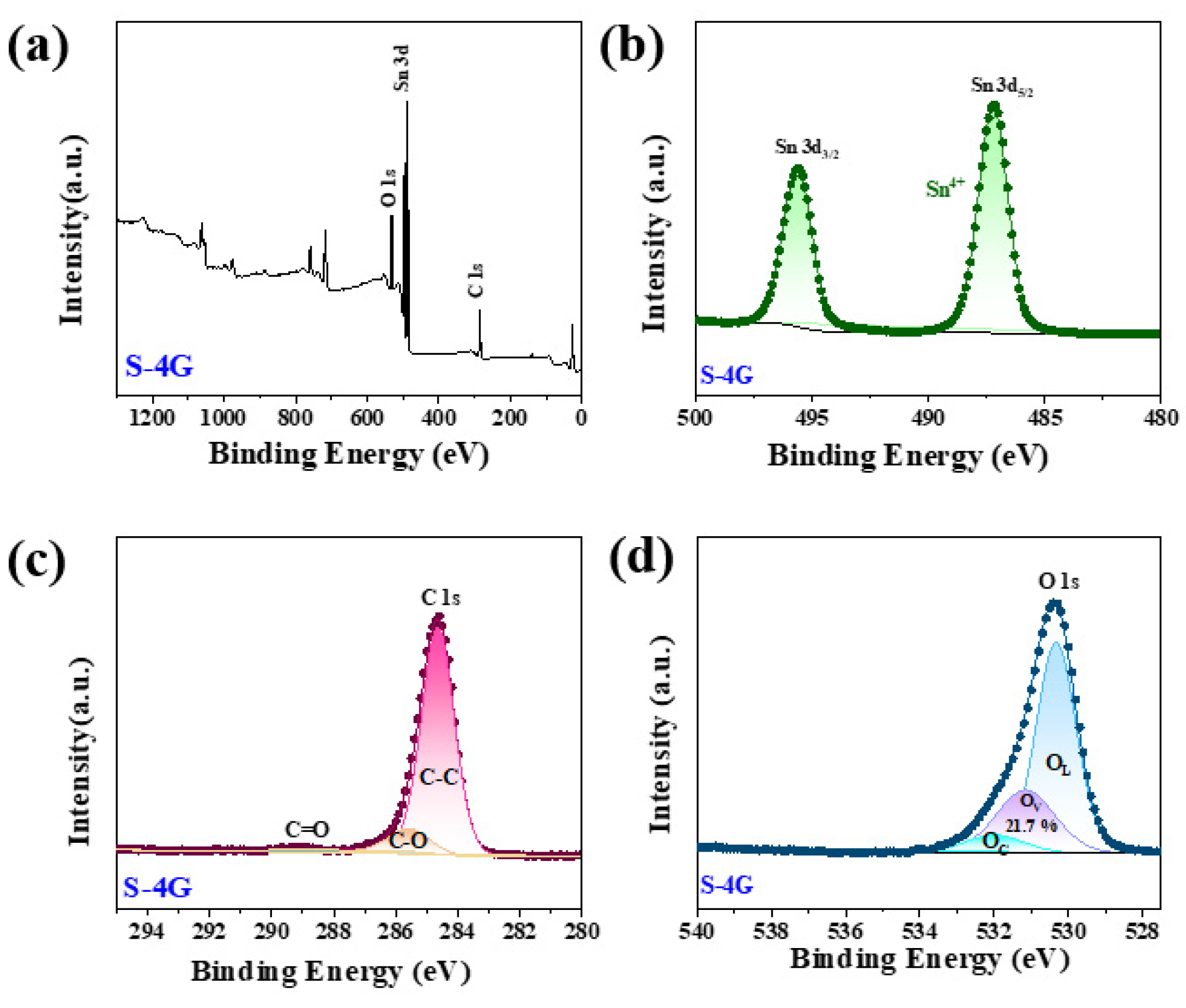

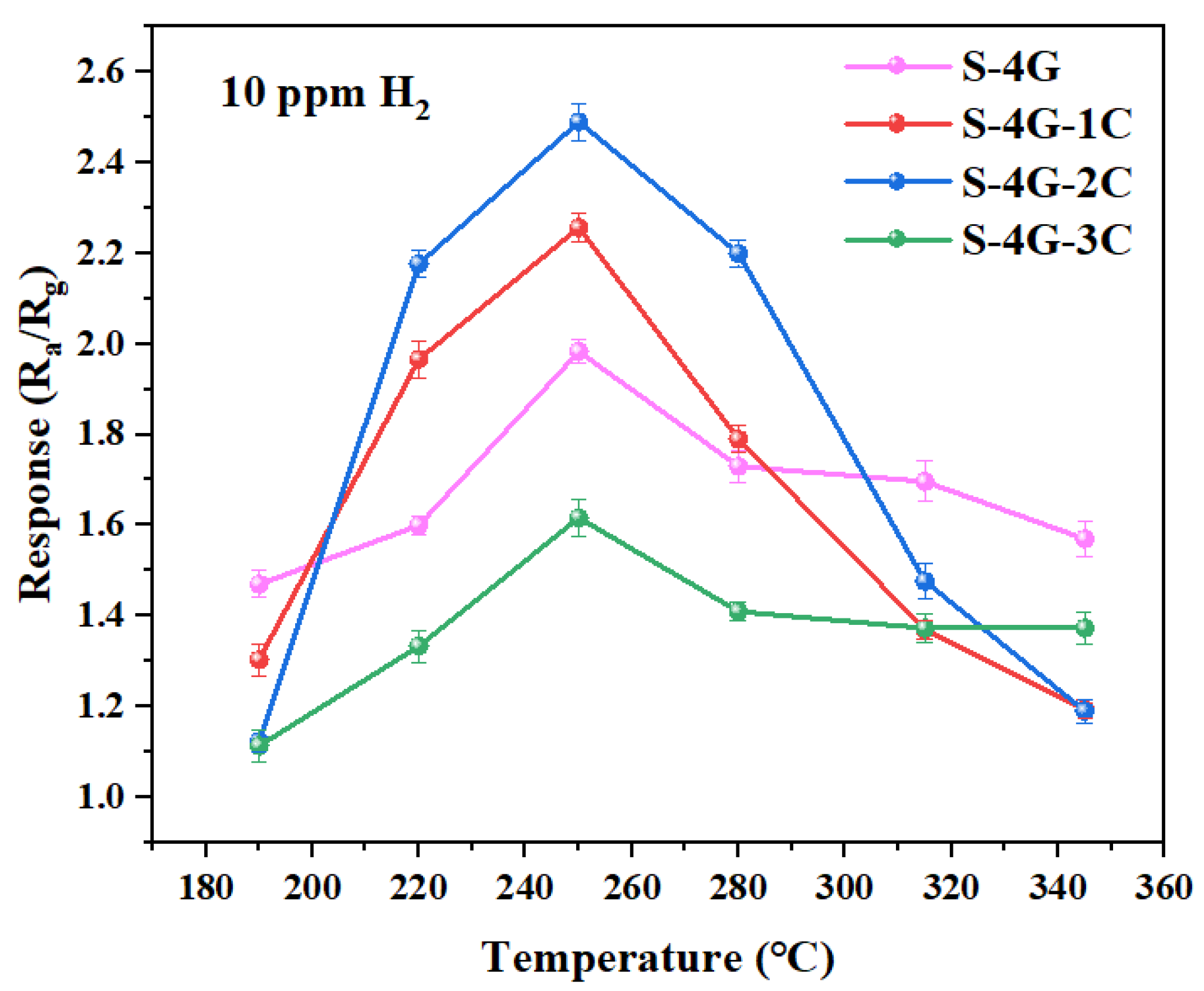

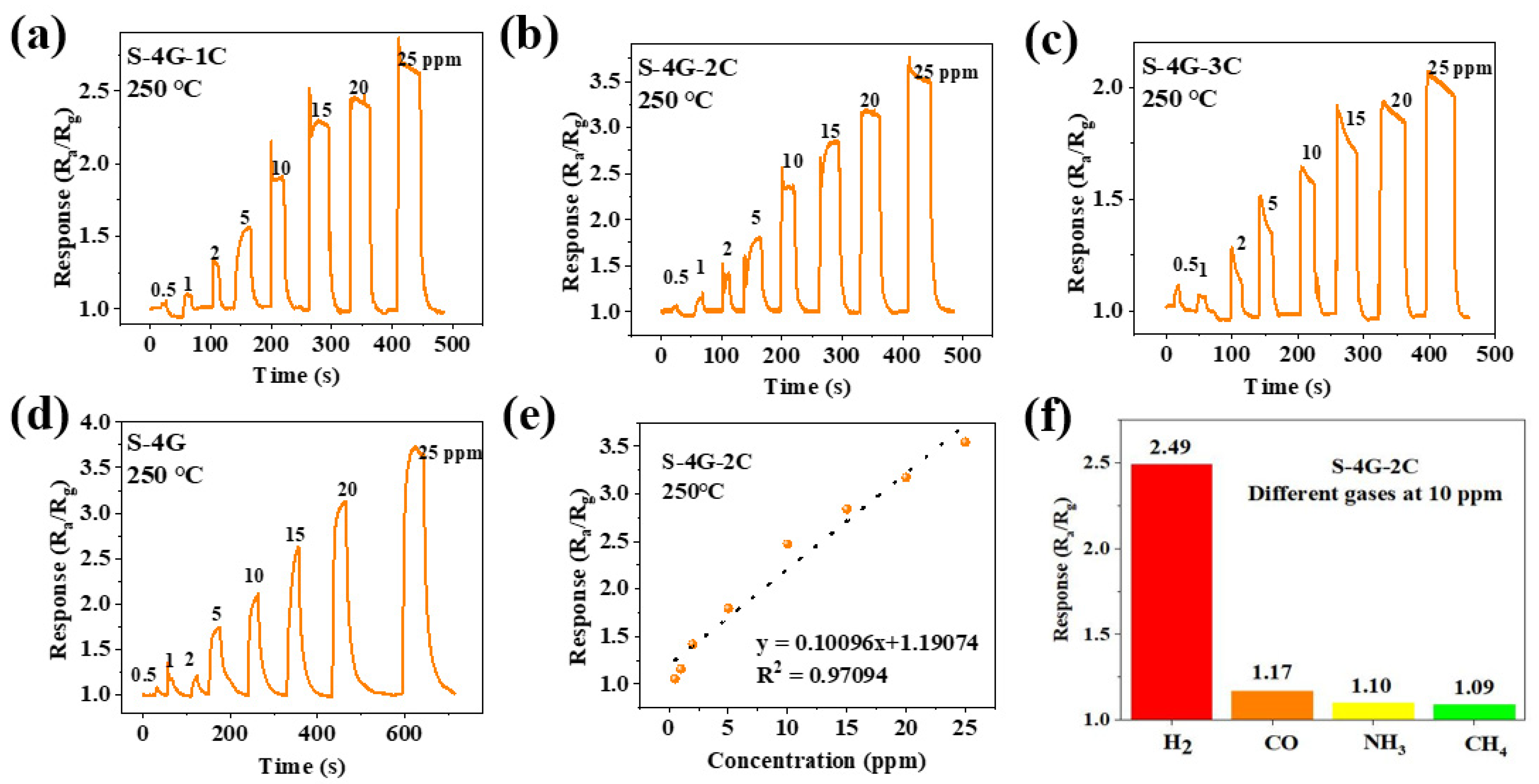
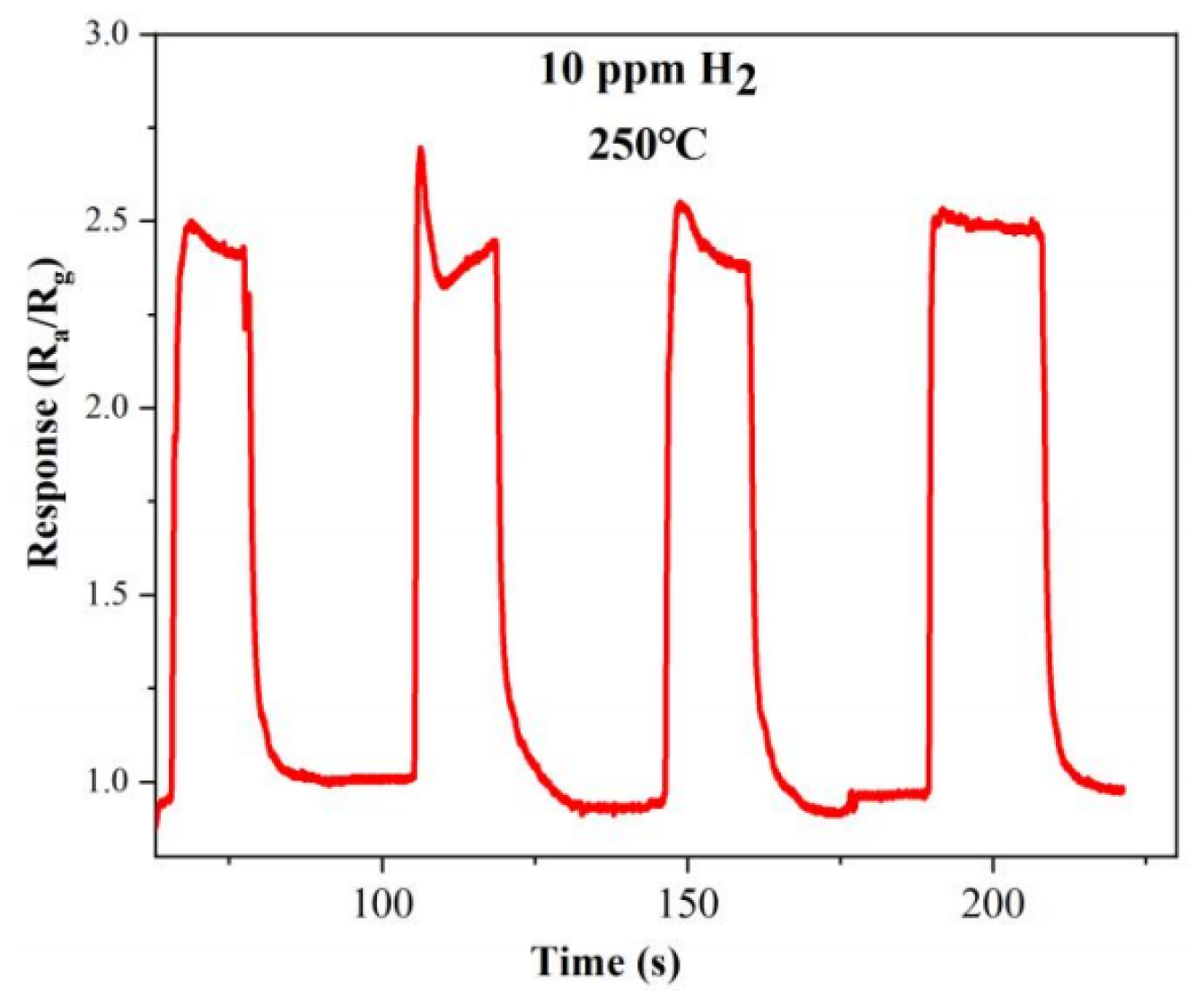
| Sample | S-4G | S-4G-1C | S-4G-2C | S-4G-3C |
|---|---|---|---|---|
| Ce content (mol%) | 0 | 1 | 2 | 3 |
| Crystallite size from XRD (nm) | 9 | 8 | 5 | 6.1 |
| Sample | Response at Different Temperatures | |||||
|---|---|---|---|---|---|---|
| 190 °C | 220 °C | 250 °C | 280 °C | 315 °C | 345 °C | |
| S-4G | 1.47 | 1.60 | 1.98 | 1.72 | 1.70 | 1.57 |
| S-4G-1C | 1.30 | 1.96 | 1.25 | 1.79 | 1.37 | 1.20 |
| S-4G-2C | 1.12 | 2.17 | 2.49 | 2.20 | 1.47 | 1.20 |
| S-4G-3C | 1.11 | 1.33 | 1.61 | 1.41 | 1.36 | 1.37 |
| Material | Working Temperature (°C) | Concentration (ppm) | Response | Response Time (s) | Recovery Time (s) | Ref. |
|---|---|---|---|---|---|---|
| Au-functionalized ZnO-branched SnO2 NWs | 300 | 10 | 13.07 | 190 | 351 | [41] |
| SnO2 thin film with a Pd island | 300 | 250 | 28 | 3 | 50 | [42] |
| Graphene-loaded Al-SnO2 nanotubes | 300 | 100 | 23.8 | 2.2 | 1.4 | [24] |
| S-4G-2C | 250 | 10 | 2.49 | 0.46 | 3.92 | This work |
Disclaimer/Publisher’s Note: The statements, opinions and data contained in all publications are solely those of the individual author(s) and contributor(s) and not of MDPI and/or the editor(s). MDPI and/or the editor(s) disclaim responsibility for any injury to people or property resulting from any ideas, methods, instructions or products referred to in the content. |
© 2024 by the authors. Licensee MDPI, Basel, Switzerland. This article is an open access article distributed under the terms and conditions of the Creative Commons Attribution (CC BY) license (https://creativecommons.org/licenses/by/4.0/).
Share and Cite
Jiao, Z.; Wang, L.; Xu, X.; Xiang, J.; Huang, S.; Lu, T.; Hou, X. Ce Doping Effects on the Hydrogen Sensing Properties of Graphene/SnO2-Based Sensors. Materials 2024, 17, 4382. https://doi.org/10.3390/ma17174382
Jiao Z, Wang L, Xu X, Xiang J, Huang S, Lu T, Hou X. Ce Doping Effects on the Hydrogen Sensing Properties of Graphene/SnO2-Based Sensors. Materials. 2024; 17(17):4382. https://doi.org/10.3390/ma17174382
Chicago/Turabian StyleJiao, Zijie, Lingyun Wang, Xiaotong Xu, Jie Xiang, Shuiming Huang, Tao Lu, and Xueling Hou. 2024. "Ce Doping Effects on the Hydrogen Sensing Properties of Graphene/SnO2-Based Sensors" Materials 17, no. 17: 4382. https://doi.org/10.3390/ma17174382






